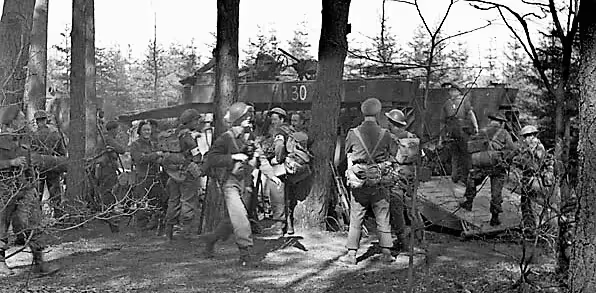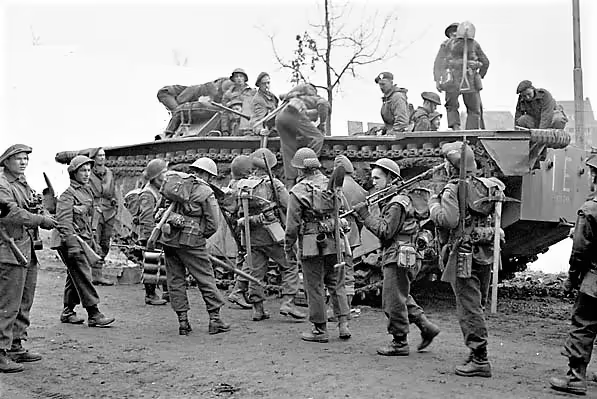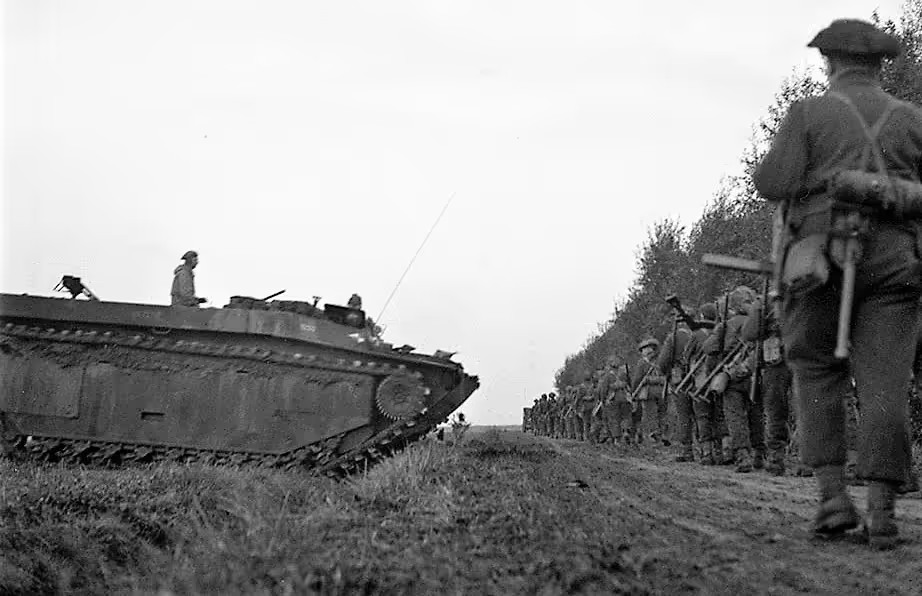Armour in Canada: Alligator and Buffalo Amphibious Vehicles, Tracked (LVT)
Alligator and Buffalo amphibious landing vehicle tracked (LVT)

(Library and Archives Canada Photo, MIKAN No. 3205259)
Jeep Ambulance being loaded onto a Buffalo LVT, 13 April 1945.

(Library and Archives Canada Photo, MIKAN No. 3524678)
Buffaloes of the Canadian Army moving up for crossing of the Rhine, near. Xanten, Germany, 24 March 1945.

(Library and Archives Canada Photo, MIKAN No. 3199041)
Buffaloes coming ashore on the river Ijssel with members of the Kings Own Yorkshire Light Infantry, 13 April 1945.
The Amphibious Vehicle, Tracked (LVT) is an amphibious warfare vehicle and amphibious landing craft, introduced by the United States Navy and United States Marine Corps. (The USN and USMC use "L" to designate Amphibious vessels, also called "L class.") The United States Army, Canadian Army and British Army used several LVT models during World War II, and referred to those vehicles as "Landing Vehicle, Tracked." Originally intended solely as cargo carriers for ship to shore operations, they evolved into assault troop and fire support vehicles. The types were known as amphtrack, "amtrak", "amtrac", etc. (portmanteaus of "amphibious tractor"), and "alligator" or "gator."
In Europe, LVTs were mainly used for landings and river crossing operations as well as assaults in swampy zones. By the end of 1943, 200 LVT-1s had been delivered to the British Army for training in preparation for future operations in Europe. The U.S., British, and Canadian armies used the Buffalo in the 1944 Battle of the Scheldt in the Low Countries, during Operation Plunder crossing of the Rhine in March 1945, along the Po River in Italy, across the river Elbe, and in a number of other river crossing operations. For the Rhine crossing, the British 21st Army Group had some 600 Buffalos available, most of them used to transport the assault infantry. As mud was expected to hamper the Sherman DD tanks, some LVTs were armed with a 20 mm cannon and two machine guns to give fire support until bridges could be constructed across the river. The "Specials" were under the 79th Armoured Division (which operated and coordinated the use of all specialist assault vehicles), that also provided Buffalos fitted with "Bobbin" carpets to create temporary roadways over the mud.
The Buffalo II had a maximum speed of 20 mph (32 km/h) on land and 5.4 kn (10.0 km/h; 6.2 mph) on water) and an operational endurance of 150 miles on land (or 75 mi (121 km) on water) the LVT-2 could carry a normal payload of 6,500 lb (2,900 kg) or 24 fully equipped troops. Portable plating of "10 lb" rating on the sponson sides and hull rear and '20lb' on the front and cab could be fitted. Rails for mounting machine guns ran round the sides and rear of the cargo space and across the back of the cab (Wikipedia)

(Library and Archives Canada Photo, MIKAN No. 3205135)
Buffaloes and North Shore (New Brunswick) Regiment, ambulance jeep going across as 8th Brigade embarks for bridgehead, 11 Oct 1944.

(Library and Archives Canada Photo, MIKAN No. 3205460)
Personnel of Princess Patricia's Canadian Light Infantry disembarking from a Buffalo amphibious vehicle used to cross the Ijssel River, 11 April 1945.

(Library and Archives Canada Photo, MIKAN No. 3191668)
Buffalo amphibious vehicles carrying troops across the Scheldt River to Hooftplaat, Netherlands, 13 Oct 1944.

(Library and Archives Canada Photo, MIKAN No. 3201095)
Infantrymen of the Princess Patricia's Canadian Light Infantry (P.P.C.L.I.) boarding a Buffalo amphibious carrier north of Zutphen, Netherlands, 11 April 1945.

(Library and Archives Canada Photo, MIKAN No. 3205459)
Soldiers of the Princess Patricia's Canadian Light Infantry boarding 'Buffalo' amphibious vehicles to cross the Ijssel River, 11 April 1945.

(Library and Archives Canada Photo, MIKAN No. 3623146)
Soldiers of the Princess Patricia's Canadian Light Infantry boarding 'Buffalo' amphibious vehicles to cross the Ijssel River, 11 April 1945.

(Library and Archives Canada Photo, MIKAN No. 3191675)
German prisoners disembarking from an Alligator amphibious vehicle, 13 October 1944.

(Library and Archives Canada Photo, MIKAN No. 3225210)
Members of the North Shore (New Brunswick) Regiment, 3rd Canadian Infantry Division loaded on an Alligator LVT waiting to move off from start line in the Netherlands, 8 Feb 1945.

(Library and Archives Canada Photo, MIKAN No. 3230680)
Captain W.A. Teed (foreground) of the North Shore (New Brunswick) Regiment, Embarkation Staff Officer of the 8th Canadian Infantry Brigade, talking with Captain C.J. Aendry, commanding officer of an Alligator amphibious vehicle, near Terneuzen, Netherlands, 13 October 1944.

(Library and Archives Canada Photo, MIKAN No. 3525752)
Infantrymen of the North Shore (New Brunswick) Regiment climbing onto an Alligator amphibious tracked vehicle during Operation VERITABLE near Nijmegen, Netherlands, 8 February 1945.

(Library and Archives Canada Photo, MIKAN No. 3239986)
Infantrymen of the North Shore (New Brunswick) Regiment boarding an Alligator amphibious vehicle during Operation VERITABLE near Nijmegen, Netherlands, 8 February 1945.

(Library and Archives Canada Photo, MIKAN No. 3205136)
North Shore (New Brunswick) Regiment soldiers pass alligators preparing for a water-borne attack as 8th Brigade embarks for bridgehead in the Netherlands, 11 October 1945.

(Library and Archives Canada Photo, MIKAN No. 3225211)
Soldiers of the North Shore (New Brunswick) Regiment, 3 Canadian Infantry Division., marching up to amphibious Alligators, in preparation for amphibious operations on the Western Front, 8 February 1945.

(Library and Archives Canada Photo, MIKAN No. 3199886)
Soldiers of The Cameron Highlanders of Ottawa (M.G.) in an Alligator amphibious vehicle on the Rhine River west of Rees, Germany, 24 March 1945.

(Library and Archives Canada Photo, MIKAN No. 3205797)
Buffaloes of the 49th Division rolling under a railroad bridge in the attack on Arnhem, 13 April 1945.




